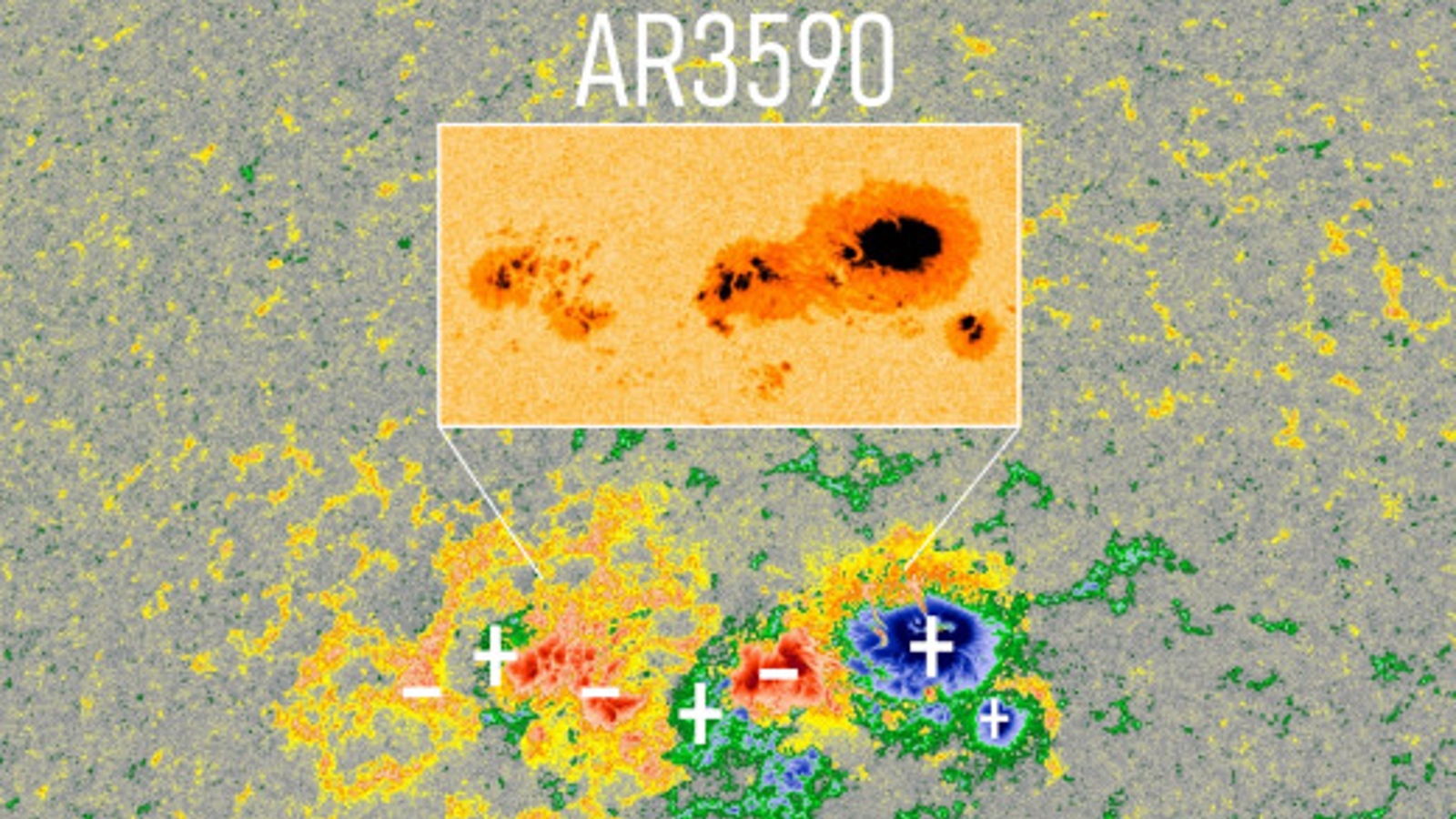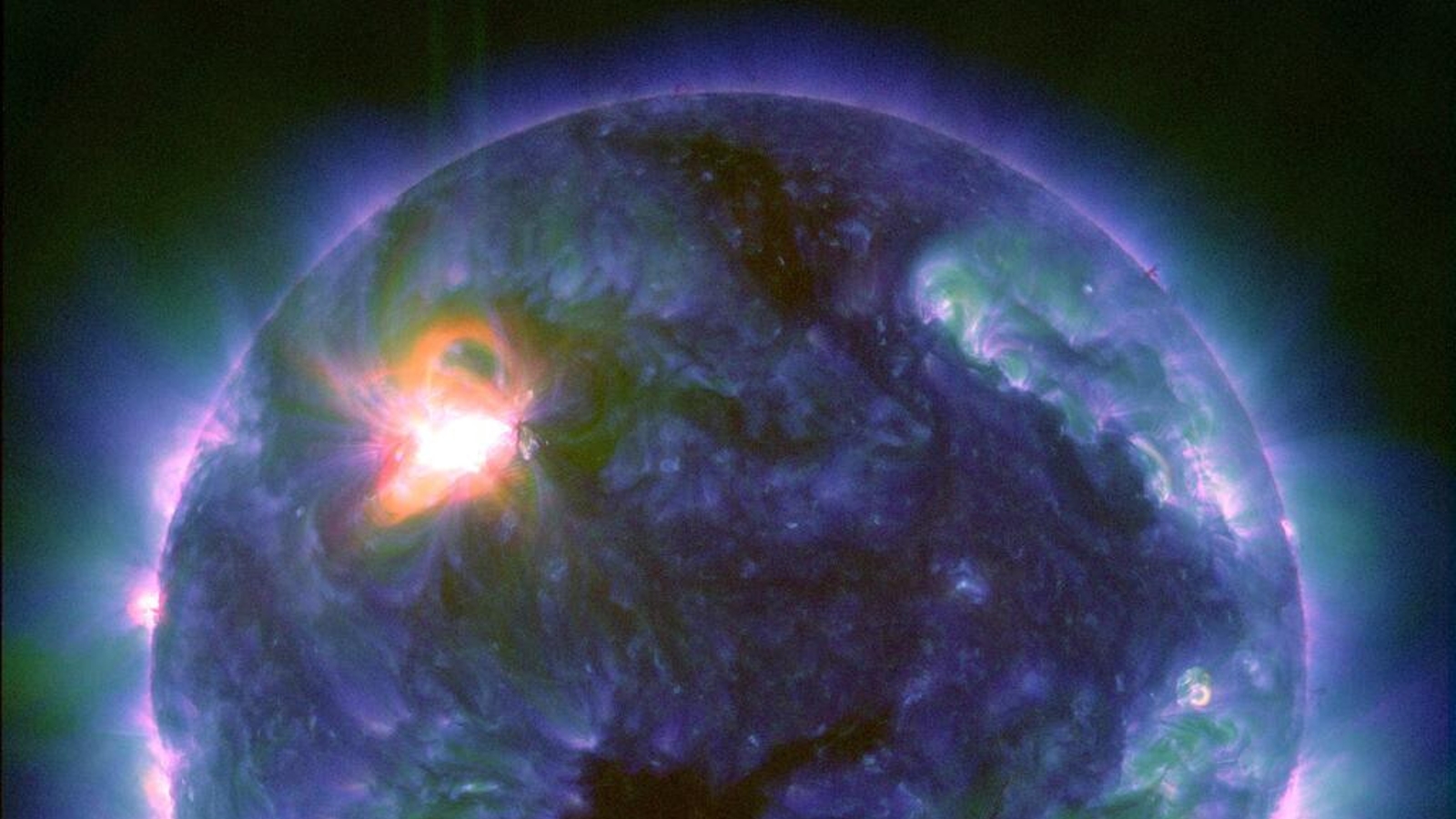Gargantuan sunspot that spit out the strongest solar flare in 6 years is now pointing 'almost directly' at Earth
Sunspot AR3590, which recently spit out three X-class solar flares in under 24 hours, has grown even larger and is now pointed almost directly at Earth, putting us in the crosshairs of more potential eruptions.

A giant, hyperactive sunspot that unleashed three X-class solar flares in less than 24 hours last week has continued to swell and is now pointed right at Earth. A period of unsettling quiet suggests that the growing dark patch could be gearing up for another massive eruption, which could smash into our planet with potentially damaging results, Spaceweather.com reported.
Sunspot AR3590 first appeared on the sun's Earth-facing side on Feb. 18 and quickly swelled into a dark patch several times wider than our planet. On Feb. 21, AR3590 spit out a pair of X-class flares — the most powerful type of solar flare — with magnitudes of X1.7 and X1.8. On Feb. 22, the same sunspot unleashed a massive X6.3 flare, the most powerful solar explosion in more than six years.
All three flares caused temporary radio blackouts on Earth, but none of them launched coronal mass ejections (CMEs) — clouds of magnetized plasma that can slam into our planet's magnetic shield as they fly through space. If any of these sizable explosions had launched a CME at Earth, the resulting plasma clouds could have triggered severe geomagnetic storms — disturbances in Earth's magnetic field that can allow solar radiation to impact ground-based infrastructure, trigger stunning auroral displays and cause satellites to tumble back to Earth.
Since the triple X-class flares, AR3590 has continued to grow, almost doubling in size. It is now one of the largest sunspots of the current solar cycle, which began in 2019, Spaceweather.com reported.
Experts predicted that the sunspot's unstable magnetic field "harbors energy for more X-class explosions," but so far, it has managed only a couple of weak M-class flares (the class below X-class) since the triple flares erupted, Spaceweather.com previously reported. This suggests the sunspot could be storing energy for another massive explosion.
The giant sunspot is currently pointing "almost directly" at Earth, according to Spaceweather.com. So, if another significant X-class flare does explode from the sun and launch a CME, our planet will be right in the firing line.
Related: 15 signs the sun is gearing up for its explosive peak — the solar maximum
Get the world’s most fascinating discoveries delivered straight to your inbox.
AR3590 is now around 60% the size of the monster sunspot that birthed the Carrington Event — a massive solar storm in 1859 that is thought to be the largest solar storm in recorded history to hit Earth.
If a Carrington Event-level flare launched a CME at Earth today, it could cause long-term disruption to global power grids and wipe out most of the spacecraft in orbit around Earth, resulting in trillions of dollars' worth of damage. AR3590 is not large enough to trigger this type of solar storm, but even if it hurled a CME that was half as powerful at us — which is possible — it could still cause serious problems.
The recent increase in the size and frequency of sunspots, as well as more frequent and powerful solar storms, are clear signs that the sun is fast approaching the explosive peak in its roughly 11-year cycle, known as solar maximum.
Scientists now think that solar maximum could arrive within the first half of this year, which is much sooner than experts originally predicted. It will also likely be much more powerful than scientists initially expected.
As a result, there is a decent chance that even if AR3590 doesn't chuck anything nasty at us, we could still be hit with a supercharged solar storm at some point in the next few years.

Harry is a U.K.-based senior staff writer at Live Science. He studied marine biology at the University of Exeter before training to become a journalist. He covers a wide range of topics including space exploration, planetary science, space weather, climate change, animal behavior and paleontology. His recent work on the solar maximum won "best space submission" at the 2024 Aerospace Media Awards and was shortlisted in the "top scoop" category at the NCTJ Awards for Excellence in 2023. He also writes Live Science's weekly Earth from space series.




